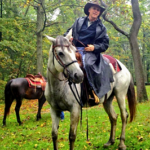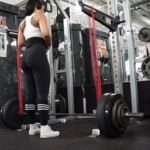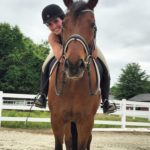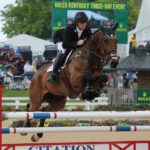Back at the Knee: A conformational fault where the upper leg is set back in comparison to the lower leg. This fault is more serious than over at the knee because it places additional strain on the tendons running down the back of the lower leg.
Back-breeding: The practice of breeding back to a certain stallion to preserve a particular desirable trait.
Bald-Faced: US term used to describe a horse with a predominantly white face.
Bandy-legged: Where the hocks turn outward. (See also bow-hocks). Opposite of cow-hocks.
Banged tail: A tail which has been trimmed level at the bottom, seen in dressage horses and hunters, but not in Arabians and western pleasure horses.
Barn Sour: Horse that objects to being ridden away from the barn. Also herd bound horses that object to leaving their pasture mates.
Barrel: The area of the horse’s body between the forelegs and the loins.
Barrel Racing: A timed event in Western Riding where horse and rider complete a cloverleaf pattern around three barrels.
Bars: In the horse’s mouth, the fleshy area between the front and back teeth, where the bit rests.
Bascule: Term used to describe the arc a horse makes as it jumps a fence.
Bashkir Curly: Breed of horse exhibiting a unique curly coat. Also called simply the Curly Horse.
Bat: Artificial aid by which the rider may emphasize and back up the natural aids of seat and legs. Used to encourage reluctant or lazy horses to move forward. Sometimes used to punish. See also whip and crop.
Bay: Coat color – deep reddish brown with black mane and tail.
Behind the Bit: An evasion where the horse holds his head behind the vertical, thereby decreasing the rider’s control. See also Overbent.
Belgian Draft Horse: Breed of heavy horse, originating in Belgium and used for heavy draft work. Also known as the Brabant.
Billets/Billet Straps: Straps by which the girth is attached to the saddle.
Bit: Mouthpiece, of made of metal but may be made of rubber or other man made material and held in place by the bridle, by which the rider conveys instructions to the horse.
Blaze: Elongated white marking down the front of the horse’s face. (Also called a stripe)
Blazer Horse: Breed of horse developed in 1959 by Neil Hinck in Idaho. Known for their easy maintenance and versatility.
Blemish: A permanent mark or scar made by either an injury of disease. Examples of blemishes include curbs and girth galls.
Blistering: Application of a caustic agent, or blister, to the leg. Formerly and, occasionally, still used in the treatment of a number of conditions, such as spavin, ringbone and bowed tendon. Thought to encourage internal healing in some cases.
Blood Horse: A Thoroughbred horse.
Bloodstock: Thoroughbred horses bred for racing.
Boarding Stable: Equestrian facility where horse owners may keep their horse for a monthly fee. See also Livery Stable.
Bog Spavin: Soft, synovial swelling seen on the inside of the hock. Does not usually cause lameness, unlike regular spavin.
Bone: The measurement around the leg, just below the knee or hock. This measurement determines the horse’s ability to carry weight, therefore a light-boned will be limited in weight carrying capacity.
Bosal: A braided noseband used in western equitation. Western bitless bridle.
Bots: Equine parasite.
Bow-hocks: Bandy-legged, where the hocks turn outwards. The opposite of cow-hocks.
Bowed Tendon: Injury to superficial digital flexor tendon, which runs down the back of the lower leg.
Boxy hooves: Narrow, upright hooves with a small frog and closed heel. Also called club foot.
Brabant: See Belgian Draft Horse.
Breaking, or Breaking-In: The early education of the young horse, where it is taught the skills it will need for it’s future life as a riding or driving horse.
Breed: An equine group bred selectively for consistent characteristics over a long period of time.
Bridle: Item of equipment worn on the horse’s head, enabling the rider to communicate his wishes through use of the bit and the reins.
Bridoon: Snaffle bit used in conjuction with a curb bit in a double bridle.
Brindle Horse: Breed of horse exhibiting a distintive marbelized coat coloring, similar to that seen in brindle dogs.
Brood Mare: A mare used for breeding purposes.
Broken-In/Broke to Ride: Horse that has been accustomed to the tack and the rider and has begun initial training. (Also called greenbroke)
Broken Winded: Term used to describe horses having an abnormal breathing pattern due to Chronic Obstructive Pulmonary Disease (COPD). Also known as heaves.
Brushing: Where the hoof or shoe hits the inside of the opposite leg, at or near the fetlock. Usually caused by poor conformation or action.
Brushing Boots: Item of horse equipment used to protect the horse’s legs from injury due to brushing.
Buck: A leap in the air with the head lowered and the back arched.
Buckskin: Coat color – body can range from creme to dark bronze, mane, tail, legs and tips of ears are black or dark brown. Horses showing similar coloration, but with a dorsal stripe, are called dun.
Back to Index







